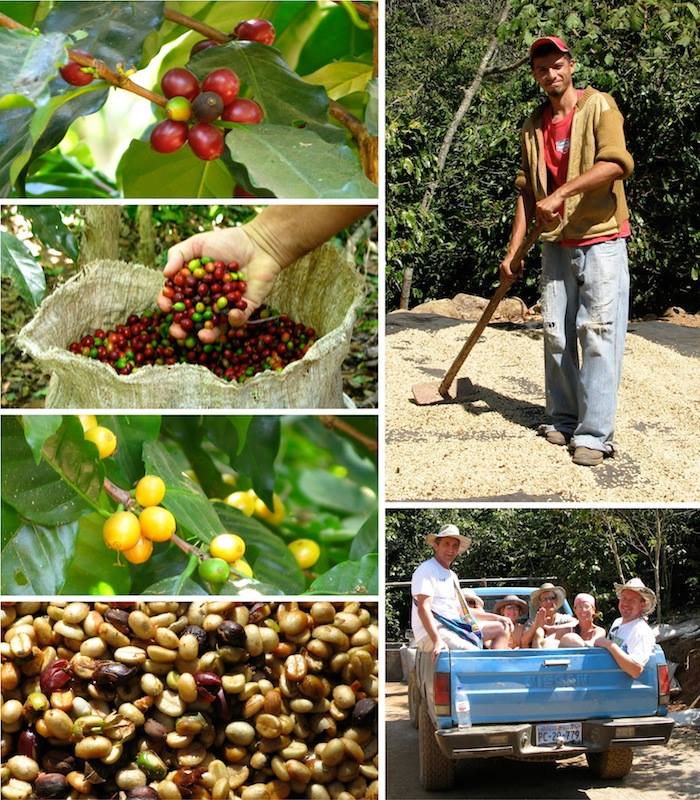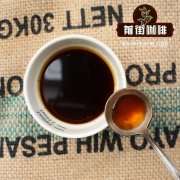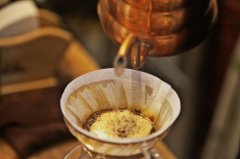How many coffee terms do you know?
There are several important concepts that must be understood in coffee extraction: the word extraction comes from Latin, meaning to squeeze something out or to obtain an extract. In chemistry, extraction refers to the acquisition of valuable substances (flavors) from raw materials (coffee beans). There are many methods of extraction, the most common of which is to use hot water to extract flavor from coffee powder. Cooking is also often used to replace the word extract.
Excessive extraction: refers to the contact time between coffee powder and hot water is too long, or the ratio of coffee powder to water is too low. When using a drip coffee machine and brewing espresso, excessive extraction is caused by grinding. When cooking by hand, the extraction time may be too long. Excessive water temperature can also lead to over-extraction. Excessive extraction will extract too many unwanted chemicals, such as caffeine, and make the coffee taste bitter and uneven.
Insufficient extraction: refers to the fact that the contact time between the coffee powder and hot water is too short to extract all the flavors from the coffee powder, which can make the coffee taste thin, bitter and uneven. Insufficient extraction may also be caused by coarse grinding or low water temperature. if the ratio of coffee powder to water is too high, you will get underextracted espresso, which not only lacks the characteristics of coffee, but also has a bitter taste.
Extraction time: refers to the time that coffee powder comes into contact with water, which is a very important variable for good coffee. Other nouns, such as brewing time or soaking time, also refer to extraction time.
Powder-to-water ratio: refers to the ratio of coffee powder to water. In order to achieve the best flavor balance, every gram of coffee powder and every milliliter of water are essential.
About coffee utensils * Propeller bean grinder: a bean grinder with a knife shaped like a propeller.
* disk type bean grinder: a bean grinder whose knife is of flat plate type.
* Cone bean grinder: a bean grinder with a tapered knife.
* Bean storage tank: the space above the bean grinder to store coffee beans.
* Bean trough: the place at the bottom of the bean grinder to receive the ground coffee powder, and the bean trough for business use is usually the dispenser.
* dispenser: a tool for quantifying coffee powder, usually combined with the bean trough of a bean grinder.
* weight reduction board: the small parts attached to some mocha pots are mainly designed to allow users to put less coffee powder.
* pressure relief valve: the valve used to remove the pressure in the cartridge, which will be opened when the pressure reaches the set pressure.
* pressure valve: the valve designed for the accumulation pressure in the cartridge is constructed the same as the pressure relief valve, but with different functions.
* flannel: a material of flannel, which refers to the way flannel is used to filter coffee powder in Zichong coffee.
* Metal filter: in the filter type, the brewing method of coffee powder is filtered by using metal with very fine holes.
* Upper pot: the upper half of the plug kettle.
* Pot: the lower half of the stopper.
The term "Espresso" refers to brewing a cup of Espresso from a single portion of coffee beans (about 7g-9g).
The special term "Espresso" refers to the brewing of Espresso from coffee beans of double portions (about 14g-18g).
The term "Espresso" refers to brewing a cup of Espresso out of three times the amount of coffee beans (about 21g-27g).
* filter: the parts of the Espresso machine containing coffee powder will have different capacities according to different types.
* boil the head: where the Espresso machine comes out of the water.
* filter handle: in an Espresso machine, the handle of the filter is locked on the head of the filter when cooking.
* non-porous filter: filter handle with no outlet, used to clean the brewing head and internal pipe of Espresso coffee machine.
* pump: a device in an Espresso machine that pressurizes water.
* Filler (powder hammer): a tool for compacting coffee powder, preferably made of metal.
* Drum bean roaster: another name is drum bean dryer, whose baking chamber is barrel-shaped and can be rotated to stir coffee beans when roasting.
* Direct-fired bean roaster: a roaster that has no complete barrier between pyrogen and coffee beans and can directly heat and roast coffee beans.
* Air flow bean roaster: a bean roaster that uses hot air to bake coffee beans.
* semi-direct-fire bean dryer: a roaster with both air-flow and direct-fire heating.
Coffee flavor wheel is a professional tool to compare and evaluate the aroma, taste and taste of coffee. This article gives a detailed explanation of the terms mentioned in this flavor wheel. It is of great reference value.
(flavor): it is the overall impression of aroma, acidity and mellowness, which can be used to describe the overall feeling of a certain coffee. For example, this coffee has a unique flavor, or it has the flavor of white chocolate.
(acidity): it is the acidity common to all coffee that grows high. Strong taste. Unlike bitter or sour (sour), it has nothing to do with pH.
Body (mellowness): the taste of brewed coffee after drinking. The change of mellowness can be divided into light, medium, high, fat, and even some Indonesian coffee is as thick as syrup. Other reference adjectives include bland (light)-coffee grown in lowlands is usually light in taste; coffee with insufficient powder and too much water will have the same light effect.
(smell): the smell and aroma of brewed coffee. The adjectives used to describe smell () include caramel, carbon roasted, chocolate, fruit, grass, malt, rich, rich, spicy and so on. (see the picture above for details)
Soft: often used to describe the mild taste of low-acidity coffee.
(spice): a flavor or smell reminiscent of a particular spice. For example, Indonesian plateau coffee (especially old coffee) has the smell of cardamom, while Guatemala Antigua coffee has the spicy taste of pepper, which can be described by this word.
Wild: describe coffee as having an extreme taste that reminds you of the vast grasslands of Africa.
(sweet): it is a commonly used adjective to describe coffee without sharp flavor.
(strong): in terms of popular usage, strong describes the strong flavor of deep-roasted coffee.
(Xin lie): similar to the sour taste of fermentation, it is almost like fruit in nature, and it has something to do with the taste of wine. Coffee grown in Costa Rica usually has a pungent flavor.
Winy (wine taste): describes a charming taste reminiscent of wine, while colleagues contain fruit-like acidity and lubricating mellowness. Kenyan coffee is the best example of wine flavor.
Sour (sour): this taste can only be produced on both sides of the tongue, which is characteristic of light roasted coffee.
(salty): after brewing, if the coffee is overheated, it will produce a salty taste.
(bitter): bitterness is a basic sense of taste, and it is also the usual taste of coffee. The bitterness of deep-roasted coffee is deliberately created, but if the coffee is particularly bitter, it may be due to the excessive use of coffee powder.
(uniqueness): describes coffee with a unique aroma and special flavor, such as flowers, fruits and spices.
Mild (mild): indicates that some kind of coffee has a harmonious and delicate flavor. Latin American premium coffee grown on the plateau is usually described as mild in texture. In addition, it is also a coffee term used to refer to all plateau coffee except those produced in Brazil.
(earthy aroma): it is often used to describe spicy coffee with an earthy smell. Sometimes people say it is a kind of earthy smell. But this adjective is not derogatory, dried coffee beans usually have this flavor, and it is precisely the special taste that many people pursue.
Aromatic alcohol: an adjective for coffee with low to medium acidity and good balance.
* drying: the use of sunlight to separate the pulp of coffee from the seeds to obtain raw beans.
* washing: the use of water to separate the pulp of coffee from the seeds to obtain raw beans.
* semi-washing: the way in which the first half is sunburned and the second half is washed to separate the coffee pulp from the seeds to obtain raw beans.
* aged beans: preserve raw beans in good condition for several years to develop a deeper flavor.
* boutique coffee: coffee, which is extremely carefully processed from planting and harvesting, can be said to be the top product in the coffee industry, which is different from the coffee produced in large quantities. At present, there are boutique coffee associations (SCAA and SCAE) in the United States and Europe, which specialize in the promotion of boutique coffee.
* Arabica (Arabica): coffee variety, the only coffee variety with 44 chromosomes, is of good quality but not easy to take care of, and is currently the most important variety in the coffee market.
* Robusta: a variety of coffee with large output, easy to take care of but poor quality. It is mainly used to make instant coffee. Robusta is the main variety second only to Arabica on the market.

Important Notice :
前街咖啡 FrontStreet Coffee has moved to new addredd:
FrontStreet Coffee Address: 315,Donghua East Road,GuangZhou
Tel:020 38364473
- Prev

Does water temperature matter when coffee is extracted?
In the brewing process, water and coffee will undergo some complex chemical reactions, and the water temperature will directly affect the extraction rate of different components in the coffee during brewing. Water extracts quinic acid, amino acids and tannins, caffeine, oils and other substances from coffee. During the cooking process, different stages produce different reactions. The temperature of water affects the extraction of coffee liquid.
- Next

Do you know how many details you might overlook in terms of coffee brewing?
First, coffee bean error 1: there are all kinds of bean grinders on the market, and a good bean grinder can ensure that the coffee powder is evenly ground. If the coffee powder is uneven and the fine powder is too much, it will make the coffee taste "pure". What is the suitable thickness of hand-brewed coffee beans? The answer is: moderate grinding, the size of granulated sugar.
Related
- Beginners will see the "Coffee pull flower" guide!
- What is the difference between ice blog purified milk and ordinary milk coffee?
- Why is the Philippines the largest producer of crops in Liberia?
- For coffee extraction, should the fine powder be retained?
- How does extracted espresso fill pressed powder? How much strength does it take to press the powder?
- How to make jasmine cold extract coffee? Is the jasmine + latte good?
- Will this little toy really make the coffee taste better? How does Lily Drip affect coffee extraction?
- Will the action of slapping the filter cup also affect coffee extraction?
- What's the difference between powder-to-water ratio and powder-to-liquid ratio?
- What is the Ethiopian local species? What does it have to do with Heirloom native species?

